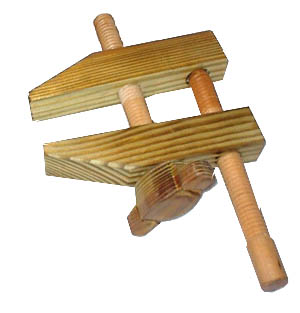Top Page > Clamps as Products > Makers of Wooden Clamps (WC) > Kirt Grayson, modern maker
Kirt has told me of discovering the design of his clamps while he was in Europe. He believes the origins can be traced back to Renaissance artisans.
To tell the story in his own words:
I was stationed in Linz, Austria in the early 1950s. In my leisure time, I would travel in to the countryside and meet with some of the locals. I became friends with a wheelwright who made or repaired wheels for horsedrwan wagons, which was faciniating to me. I noticed the clamps he was using, and offered him 100 schillings (about 4$ US) for one. Although it looked very old, it was a very strong clamp.
I showed the clamp to Dr. Joseph Grammer, who was my teacher in a USAFI extension course I was taking. He was knowledgable of the history of this type of tool. It is a simple, but very clever mechanism, where the central wooden screw not only serves as a closing device, but also is a fulcrum when the rear screw is tightened (with very little effort) causing it to grip with tremendous force. Dr. Grammer told me that this type of clamp was commonly used for erecting structures, scaffolding, etc.
Now that I am retired, I have been wood carving as a hobby, and have been making, using, and selling some.
Kirt died in 2013; his obituary provides more details of his life.
Kirt has said that he is primarily a carver, but he likes to use the tools used by his predecessors. For some of these, he has to make his own. In particular, he made his own clamps, of a unique design, and sold them through Star Discount Tool. His website, now down, had examples and details of his carvings.

I know of no marks.
The jaws appear as usual. However, there is a subtle
difference. We cannot speak of the threaded
jaw, as
some do. Each jaw has a threaded hole. It is quite clear in
the picture, that the central spindle engages threads in the
jaw opposite to its handle.
The spindles are not anti-parallel in their action. Rather, the handles are on the same side. When used to erect scaffolding, or for other projects, this arrangement provides convenient access for tightening, or loosening.
The spindles do not have the usual handles. Rather the central spindle has a knob well suited for hand tightening, while the terminal spindle has a handle pierced for greater leverage.
last revised and validated
Copyright © 1996- Wooden Clamp Journal